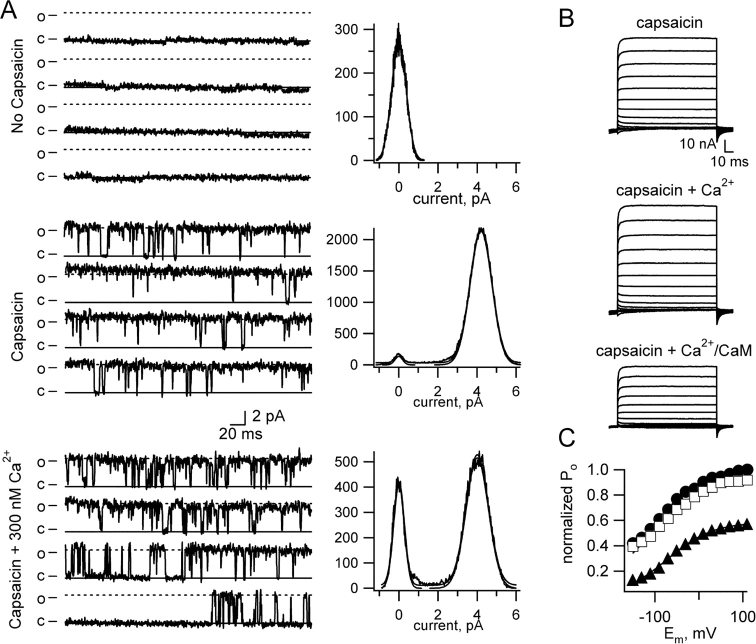Figure 4.
Ca2+/CaM inhibition of TRPV1 reflects a decrease in channel open probability. (A) Currents from a patch containing a single TRPV1 channel in the absence of both capsaicin and Ca2+ (top), in the presence of 4 μM capsaicin but no Ca2+ (middle), and in the presence of 4 μM capsaicin and 300 nM free Ca2+ (bottom). Consecutive traces at +60 mV are shown. All-points histograms were made from all data collected under each condition (2 s without capsaicin, 12 s with capsaicin in the absence of Ca2+, and 6.1 s for capsaicin plus Ca2+). Open probabilities were taken from the area under the Gaussian representing open channels relative to the sum of the area under the Gaussians representing the closed and open channels, and were as follows: capsaicin alone = 0.99, capsaicin + Ca2+ = 0.72. For this experiment, the channels were expressed in Xenopus oocytes. (B) Currents in response to steps from a holding potential of −120 mV to between −150 mV and +110 mV, in steps of 20 mV. After the voltage steps the potential was returned to −120 mV. Currents activated by 20 μM capsaicin (top), capsaicin + 50 μM free Ca2+ (middle), or capsaicin + 50 μM free Ca2+ and 500 nM CaM (bottom). (C) Instantaneous currents measured upon the return of the potential to −120 mV plotted versus the step potential preceding this repolarization. Currents activated by 20 μM capsaicin (circles), capsaicin + 50 μM free Ca2+ (squares), or capsaicin + 50 μM free Ca2+ and 500 nM CaM (triangles). The currents were normalized to the maximum current activated by capsaicin (without Ca2+ or CaM). Solid curves are fits with the Boltzmann equation with the following parameters: capsaicin: z = 0.41e0 (elemental charge), V1/2 = −122 mV; Ca2+: z = 0.31e0, V1/2 = −109 mV; Ca2+/CaM: z = 0.2e0, V1/2 = +40 mV.

